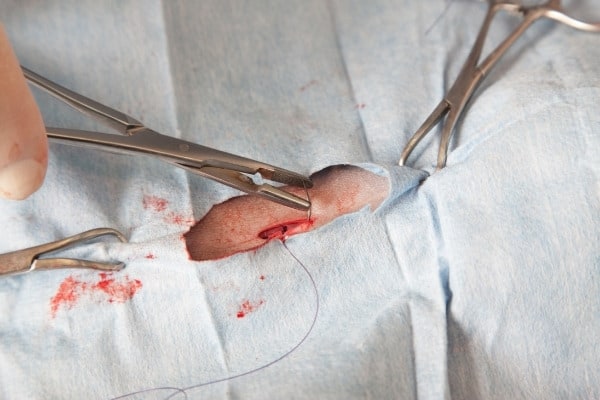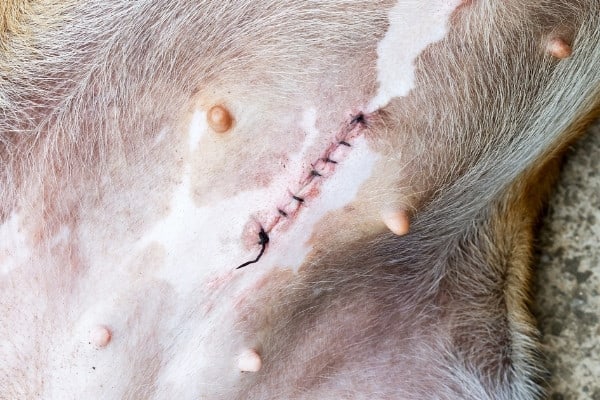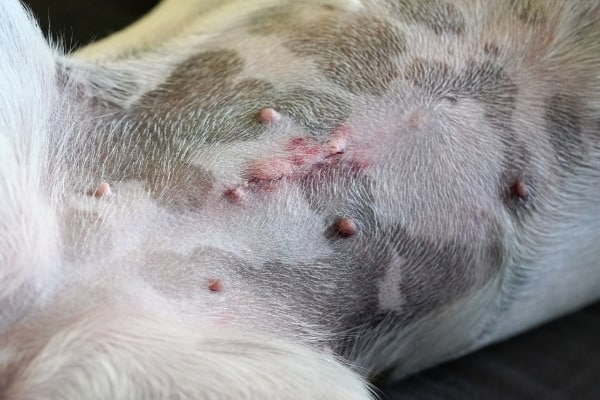
Veterinarians recommend spaying your dog at a young age to avoid illnesses, injuries, and unwanted puppies.
Spaying is a common procedure that veterinarians perform every day, and it typically has a quick recovery time.
If you are planning to have your dog spayed or if you recently had your dog spayed, you should monitor her and ensure the incision is healing properly and your dog is recovering well.
What should a spay incision look like? A spay incision should be completely closed with no gaps, bleeding, swelling, redness, or bumps around the opening. As the incision heals, it should appear smaller and lighter in color. If you notice redness or swelling, it could be a sign of infection.
If you have recently had your dog spayed, you may be keeping a close eye on the incisions to ensure it is healing properly.
Read on to learn more about what the incision should look like as it heals.
Monitoring Your Dog’s Spay Incision – What To Expect
It is important to monitor your dog closely after she has been spayed.
Keep an eye on the incisions to ensure it is healing properly and is showing no signs of infection. The incision will change its appearance as it heals.
Spay Incision Appearance – Days 1-3
The incision will appear fresh but should be completely close and not leaking any fluid or showing any signs of bumps or redness.
It will look like a thin scar or wrinkle on the skin. It may be slightly pinker than the surrounding skin and be soft and tender to touch.
Spay Incision Appearance – 1 Week After Surgery
After a week, the incision should be much less pink but should still appear to be dry and smooth.
The wrinkle or scar may have faded, and the skin around the incision will be more firm.
Spay Incision Appearance – 2 Weeks After Surgery
The incision should be almost completely healed within two weeks. Any swelling or redness should be completely gone, and the skin should be firm.
The dog should not react in pain if the area is touched. The scar will appear more faded, and the hair around it should be growing back.
When Will My Dog Be Fully Recovered After a Spay?
The incision from the spay should start to heal within two to three days. Your dog should start feeling better after around 24 hours.
The dog may seem sore and tired for two to three days after the surgery but will improve each day. Most dogs fully recover within a week of surgery.
Pictures of Normal Spay Incisions


When To Be Concerned About Your Dog’s Spay Incision
You should check your dog’s spay incision a few times a day until it is fully healed.
You should be concerned if the incision appears to have excessive swelling, is bright red, leaks fluid, has red bumps around it, or if the incision opens back up.
If you are concerned about your dog’s incision, make an appointment with your veterinarian.
How Do I Know If My Dog’s Incision Is Infected?
There are some signs of infection that you should watch for after your dog is spayed. Common signs of infection include:
- Swelling
- Redness
- Rash
- Leaking fluid
- Bumps
- Hot to touch
Dog Spay Incision Lump
As your dog’s spay incision heals, you may notice that a lump appears near the incision area. This is called a seroma, and it is normal.
A seroma can consist of fluid and scar tissue. It should become less noticeable as the incision heals and will eventually go away.
If the lump becomes red or odd in shape or starts to open up and bleed, take your dog to a veterinarian immediately.
Related Questions:
What Age Should a Dog Be Spayed?
Some veterinarians recommend that dogs be spayed between the age of four to six months.
Others recommend larger dogs wait until at least six months of age to avoid certain cancers and other health issues.
Still others recommend waiting until the dog is at least a year old before having the surgery performed.
Does Spaying Reduce Aggression?
Spaying can help reduce aggression that is caused by hormonal imbalances. Dogs can be aggressive if they are trying to attract a mate or compete for the attention of another dog or even their owner.
Spaying a dog reduces the instinct to mate and means the dog no longer feels the need to compete for attention.
Conclusion
Spaying your dog can help reduce the risk of injury and certain illnesses, and it can reduce the number of strays or unwanted puppies that are born.
If you do decide to have your dog spayed, you should monitor her closely while she recovers, inspect the incision site daily, and watch for any signs of infection.




